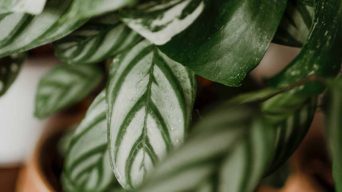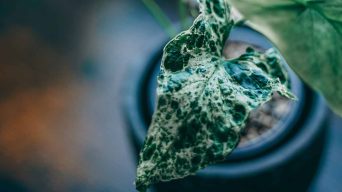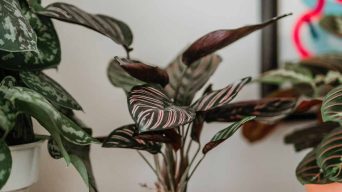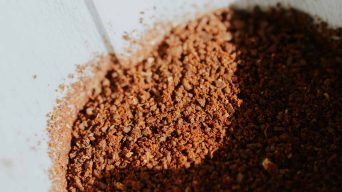Calathea plants are native to the tropical Americas and Africa.
Many of the most popular houseplants are members of this genus, including Calathea zebrina (zebra plant), Calathea makoyana (peacock plant), and Calathea ornata (pinstripe calathea).
Calatheas are known for their beautiful, brightly-colored leaves.
They are commonly called “prayer plants” because their leaves fold up at night, as if in prayer.
While calathea are generally easy to care for, they can be sensitive to environmental changes. One of the most common problems with these plants is underwatering.
This article will discuss the signs of an underwatered calathea, how to treat it, and how to prevent it.
Why Is Underwatering A Problem?
Water is essential for plants because it transports nutrients and helps support the plant’s structure.
When a plant is underwatered, it can’t take in the water and nutrients it needs to survive. This can lead to wilting, yellowing leaves, and eventually death.
In addition to being unable to take in water and nutrients, an underwatered plant is also more susceptible to pests and diseases.
Pests are attracted to stressed plants, and diseases can take advantage of a plant’s weakened state.
In severe cases, an underwatered plant may stop growing and eventually die.
How Does Underwatering a Calathea Occur
There are a few reasons why your calathea might be underwatered.
The most common reasons are:
Not Enough Water
When watering your calathea, give it enough water, so the soil is evenly moist. If the soil is too dry, the plant will start to wilt.
A good rule of thumb is to water your plant until water starts to run out of the bottom of the pot. Then, allow the plant to drain and empty the saucer.
Be sure not to water your plant again until the soil has a chance to dry out.
If you’re unsure how often to water your Calathea, check the soil before watering.
If the top inch or so of soil is dry, it’s time to water.
Inconsistent Watering
In addition to not watering your calathea enough, inconsistent watering can also be a problem.
They like to have evenly moist soil, so it’s essential to water them on a regular schedule.
In general, calathea plants need to be watered about once a week.
However, the frequency will vary depending on the size of the pot, the type of soil, and the climate.
You should also take into account the size of your plant.
A small plant will need less water than a large one.
Keep an eye on your plant and water it when the soil starts to dry out.
If you’re unsure how often to water, err on the side of too little rather than too much.
Improper Drainage
For a plant to thrive, the roots need oxygen.
If the roots are constantly sitting in water, they will start to suffocate and rot.
As a result, the roots will be unable to take up water and nutrients, and the plant will start to die.
It’s essential to make sure your pot has good drainage so that the roots don’t sit in water.
The best way to achieve this is to use a pot with drainage holes and a saucer.
If you’re using a pot without drainage holes, water it sparingly.
Wrong Type of Soil
The type of soil you use can also affect how often you need to water your plant.
For example, sandy soil drains quickly and dries out faster than other soil types.
As a result, plants in sandy soil will need to be watered more often.
On the other hand, clay soils drain more slowly and hold onto moisture longer.
This means that plants in clay soil will need to be watered less often.
Calatheas prefer a light, well-draining soil.
Hot, Dry Weather
Calatheas are native to tropical regions and prefer warm, humid conditions.
If the air is too dry, the plant will start to suffer.
In addition, hot weather can cause the soil to dry out more quickly.
Make sure to water your calathea more often during hot, dry weather.
You might also consider misting the leaves to help increase humidity.
Too Much Sun
While calathea plants need some bright indirect light, too much sun can be a problem.
Too much direct sunlight will cause the soil to dry out more quickly and can scorch the leaves.
If you think your plant is getting too much sun, move it to a spot with indirect sunlight.
Poor Root Structure
If a plant’s roots are damaged, it will be less able to take up water and nutrients.
This can happen if the roots are too crowded or have been damaged by pests or diseases.
It can also occur if the plant is grown in a pot too small.
If the roots are damaged, the plant will wilt and eventually die.
When repotting your calathea, choose a pot slightly larger than the current one.
Also, be careful not to damage the roots when repotting.
Pests
Pests and diseases can also cause underwatering.
If your plant is infested with pests, it will suck the sap from the leaves, causing it to wilt.
Pests can also damage the roots, making it difficult for the plant to take up water.
Common pests include aphids, mealybugs, scale, and spider mites.
Diseases
If your plant is infected with a disease, it will also have difficulty taking up water.
Common diseases include root rot and fungal leaf spot.
Both of these diseases are caused by too much moisture.
To prevent pests and diseases, keep your plant clean and healthy.
Remove any dead leaves or stems, and disinfect your tools before using them on other plants.
Fertilizer Burn
If you’ve recently fertilized your plant, this could be the reason it’s underwatered.
Fertilizer burn is caused by using too much fertilizer or applying it too often.
It can also occur if you apply fertilizer to dry soil.
When this happens, the roots can’t take up water, and the plant will start to wilt.
To prevent fertilizer burn, follow the directions on the fertilizer package.
Only fertilize your plant during the growing season, and don’t apply more than the recommended amount.
How To Tell If Your Calathea Is Underwatered
It’s essential to catch underwatering early on so your plant doesn’t experience too much damage.
That’s why it’s essential to know the signs of an underwatered calathea.
Signs of an Underwatered Calathea
You can look for several signs to determine if your calathea is underwatered.
These include:
Drooping Leaves
When the leaves of your Calathea are drooping, it indicates insufficient watering.
When a plant doesn’t have enough water, it cannot support the leaves, causing them to droop.
If the leaves are slightly limp, you can water the plant and see if it recovers.
However, if the leaves are severely drooped or starting to turn brown, the plant is likely too far gone and will not recover.
Yellow Leaves
Another common sign of underwatering is yellow leaves.
When a plant doesn’t have enough water, the plant is unable to transport nutrients to the leaves.
This results in the Calathea leaves undergoing a yellowing process, ultimately leading to their demise.
If you see yellow leaves on your plant, it’s essential to water it immediately.
Curling Leaves
Curling leaves is another sign that your calathea is underwatered.
When the plant doesn’t have enough water, the plant is unable to transport moisture to the leaves.
This causes Calathea leaves to curl and eventually die.
If you see leaves starting to curl, it’s essential to water the plant immediately.
Brown Spots on Leaves
Brown spots on the leaves are another sign of underwatering.
When the plant doesn’t have enough water, the leaves will turn brown and die.
This happens because the plant cannot transport moisture to the leaves, which will start to dry out and die.
If you see brown spots on your calathea leaves, it’s essential to water the plant immediately.
Wilting Leaves
Wilting leaves is another sign that your calathea is underwatered.
When the plant doesn’t have enough water, the plant is unable to transport moisture to the leaves.
This causes the Calathea leaves to wilt and eventually die.
If you see wilting leaves on your plant, it’s essential to water the plant immediately.
Leaf Drop
Leaf drop is another sign of underwatering.
When the plant doesn’t have enough water, the leaves will start to fall off the plant.
This happens because the plant cannot support the leaves, and the leaves will eventually fall off.
If you see a leaf drop on your plant, it’s essential to water it immediately.
Soft Stems
Soft stems is another sign of underwatering.
When the plant doesn’t have enough water, the stems will start to soften and eventually collapse.
This happens because the plant cannot support the stems and eventually collapse.
If you see soft stems on your plant, it’s essential to water it immediately.
Dry or Cracked Soil
Another sign of underwatering is dry or cracked soil.
When the plant doesn’t have enough water, the soil will start to dry out and eventually crack.
When the soil has been dry for too long, it will start pulling away from the pot’s sides.
If you see dry or cracked soil on your plant, it’s essential to water it immediately.
Slow Growth
Slow growth is another sign of underwatering.
When the plant doesn’t have enough water, the plant will stop growing.
This happens because the plant cannot transport moisture and nutrients to the leaves and stems.
The plant won’t be able to grow new leaves or stems and will probably die.
If you see slow growth on your plant, it’s essential to water it immediately.
How To Save an Underwatered Calathea
If you think your calathea is underwatered, there are a few things you can do to save it.
Here are a few tips:
1. Water Deeply and Thoroughly
The first thing you need to do is water deeply and thoroughly.
Water the plant until the potting soil is saturated and the water comes out of the drainage holes.
This will ensure that the plant gets enough water and the roots absorb it.
Don’t let the plant sit in water, though.
After you’ve watered it, empty the saucer so the plant isn’t sitting in water.
2. Soak the Soil
If the soil is really dry, you may need to soak it.
To do this, place the plant in a sink or tub and water it until the water comes out of the drainage holes.
Let the plant soak for 30 minutes to an hour, drain it, and put it back in its pot.
3. Use a Humidity Tray
If the air in your home is really dry, you may need to use a humidity tray.
A humidity tray is a shallow tray filled with water and pebbles.
Place the tray under the plant and ensure the water doesn’t touch the plant.
The water will evaporate and increase the humidity around the plant.
4. Mist the Leaves
Misting the leaves is another way to increase the humidity around the plant.
To do this, fill a spray bottle with water and spritz the leaves.
Do this once or twice a day until the plant is recovered.
5. Move the Plant to a Humid Location
If the air in your home is really dry, you may need to move the plant to a more humid location.
Some good places to put your plant are the bathroom or kitchen.
If you have a humidifier, you can also put the plant near it.
6. Repot the Plant
If the plant is really dry, you may need to repot it.
To do this, remove the plant from its pot and check the roots.
If the roots are dried, you’ll need to replant the plant in fresh soil.
You can put the plant back in its pot if the roots are healthy.
Ensure that the pot has drainage holes and the potting soil drains well.
7. Be Patient
It can take a while for an underwatered plant to recover.
Be patient and keep up with the watering and misting schedule.
Eventually, the plant will recover, and new growth will appear.
How To Prevent Underwatering a Calathea Plant
Overwatering is a common problem with Calathea plants, but underwatering is also possible.
Sometimes, when we think our plants are getting too much water, they’re not getting enough.
If your Calathea’s leaves are wilting, it’s more likely that the plant is thirsty rather than overwatered.
There are a few things you can do to prevent underwatering your Calathea plant:
1. Check the Soil Before Watering
The best way to tell if your plant needs water is to check the soil.
Stick your finger in the potting mix up to the second knuckle.
If the soil is dry, it’s time to water.
If the soil is wet or soggy, leave the plant alone for a few days
2. Water Deeply and Less Frequently
When you water your Calathea, give it a good soaking.
Water until it runs out of the drainage holes at the bottom of the pot. This will help prevent root rotting, which can be caused by sitting in wet soil.
After watering, empty any water collected in the saucer under the pot.
3. Use Room Temperature Water
Your Calathea will appreciate room-temperature water instead of cold water from the tap.
Letting the water sit out for a while will also help remove any chlorine or fluoride in it.
4. Group Plants Together
If you have more than one plant, group them.
Plants help regulate the humidity around them, so grouping them will create a microclimate perfect for Calatheas.
5. Use a Humidity Tray
If you can’t group your plants together or the air in your home is particularly dry, use a humidity tray.
To make one, fill a tray with pebbles and water.
Place your plant on top of the pebbles, ensuring that the pot isn’t touching the water.
As the water evaporates, it will increase the humidity around the plant.
6. Water in the Morning
Water your Calathea in the morning, so the plant can absorb the water before the hottest part of the day.
Watering in the evening can cause the leaves to stay wet overnight, leading to fungal problems.
7. Use a Moisture Meter
If you’re unsure how often to water your Calathea, get a moisture meter.
These handy devices are inserted into the soil to show how moist it is.
This takes the guesswork out of watering and can be a lifesaver for forgetful plant parents.
8. Check the Humidity Level
Calatheas need high humidity to thrive, so ensure that the air around your plant is moist.
If the air in your home is dry, run a humidifier or use a pebble tray to increase the humidity around your plant.
9. Use the Right Size Pot
When your plant is pot-bound, the roots have nowhere to go.
This can lead to underwatering, as the roots will take up all of the moisture in the potting mix before reaching the rest of the plant.
To prevent this, repot your Calathea every year or two.
Use a pot that’s only slightly bigger than your current one.
10. Keep an Eye on the Weather
If you live in an area with very hot, dry summers, keep an eye on your Calathea.
It might need water more often than usual during these months.
Conversely, if it’s raining a lot or the air is particularly humid, you can cut back on watering.
Final Thoughts
Calathea care can be tricky, but it’s worth the effort!
These gorgeous plants are sure to make any space look amazing.
Just remember to give your Prayer plant plenty of bright indirect light, keep it consistently moist (but not wet or soggy), and provide good humidity.
If you do all this, your Calathea should be happy and healthy!







